The site of Santa Rita located in the northern part of Belize, has been occupied throughout the Mayan Civilization and on into present times. Today the site is literally part of the town of Corozal. Archaeologists theorize that Santa Rita was the ancient and important Mayan city of Chetumal.
The only existing structure at the ruin dates from the Classic Period. This building is a complex series of rooms and passages. The central room appeared to be some sort of ceremonial chamber where offerings were made. Two burial chambers were uncovered here. One was that of an elderly woman complete with elaborate jewelry and pottery. The second burial chamber was that of a warloard, evident from the artifacts found near him a ceremonial flint and a stingray spine, used in bloodletting rituals.
The Postclassic Period at Santa Rita, the Period to which the importance of this site is normally attached, is revealed through artifacts rather than structures. Because the Maya of this period built low platform structures on top of which they placed buildings constructed of perishable materials, little remains of the structures of this time period.
The artifacts found at Santa Rita from the Postclassic Period reveal exotic rituals such as blood-letting, so important during the Classic Period, continued to play an important religious role. The presence of turquoise and gold ear-flakes of Aztec origin, which also date from the Postclassic Period, attest to the continuing trade importance of Santa Rita several hundred years after the decline of the major ceremonial centers of the interior.
In Pre-Columbian times, a city called Chactemal, sometimes rendered as "Chetumal" in early European sources, today's Santa Rita in Belize, was the capital of a Maya state of the same name that roughly controlled the southern quarter of modern Quintana Roo and the northeast portion of Belize. This original Chetumal is now believed to have been on the other side of the Rio Hondo, in modern Belize, not at the site of modern Chetumal.
Santa Rita has been identified as the most important center of Mayan activity in the northern section of Belize at least twice in its history. During the early Classic period, it dominated Chetumal Bay and controlled trade to and from the Rio Hondo and New Rivers. Archaeologists have identified strong trade links with major centers deep within the interior. After a short decline during the Late Classic Period, Santa Rita once again rose to promenence. With the decline of Classic sites to the north, Santa Rita became the capital of one of the 19 Mayan political entities as recorded by the invading Spanish. At that time it was called "Chactemal", corresponding to the present day Chetumal.
During the Spanish conquest of Yucatan, the Maya state of Chetumal fought off several Spanish expeditions before finally being subjugated in the late 16th century.
The 1840s revolt of the indigenous Maya peoples against Mexican rule, known as the Caste War of Yucatan, drove all the Hispanic people from this region; many settled in Corozal Town, British Honduras.
The current site of Chetumal was established as a Mexican port town in 1898, originally under the name Payo Obispo. At the invitation of founder Othon P. Blanco, the early town was populated by settlers from Belize including Caste War refugees and Englishmen. The name of the town was officially changed to Chetumal in 1936.

